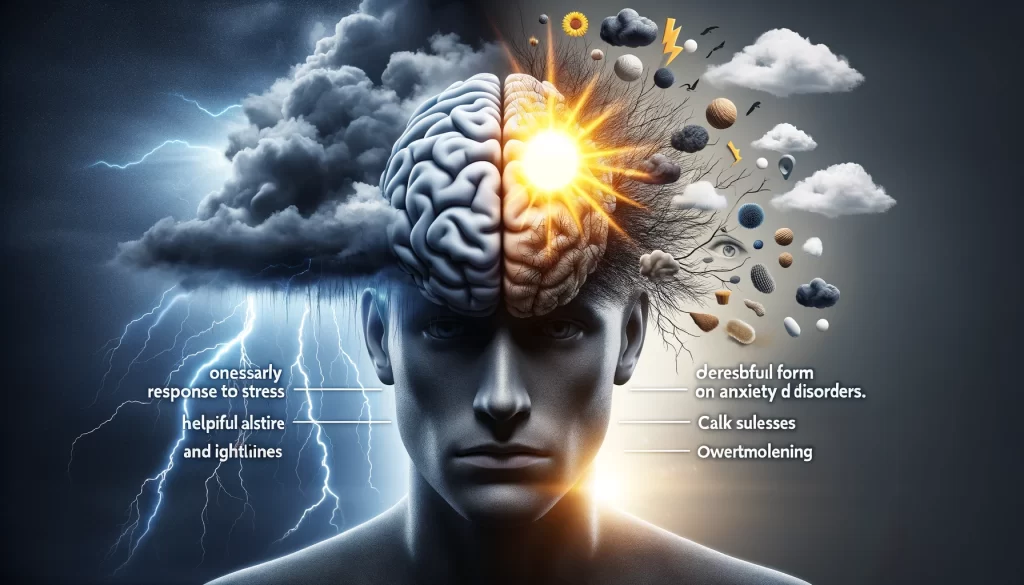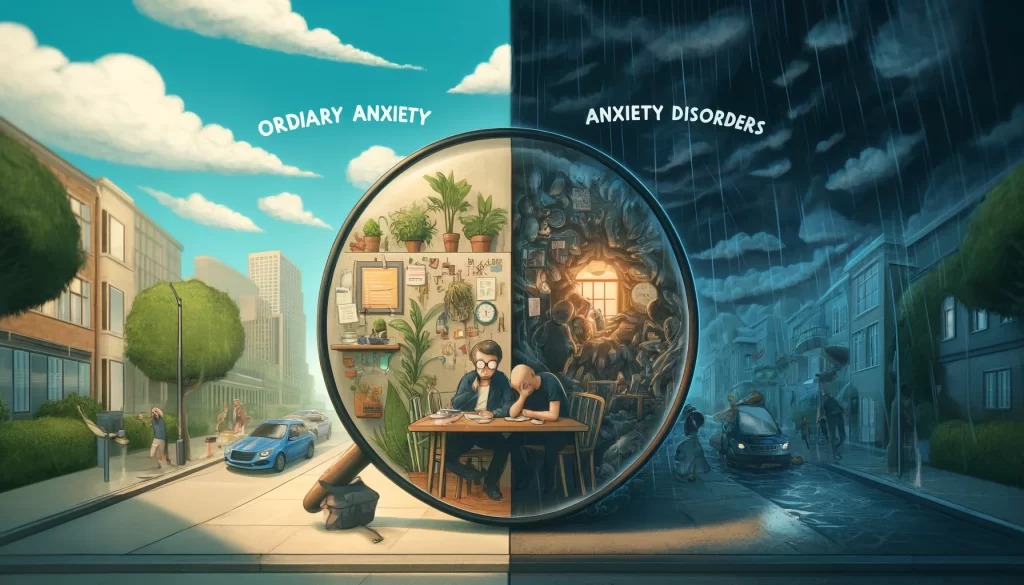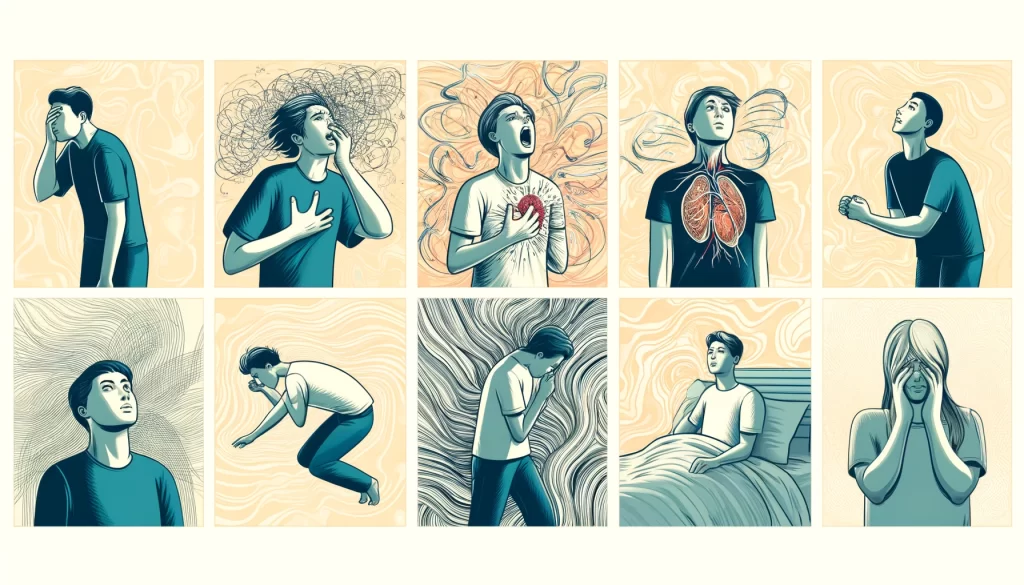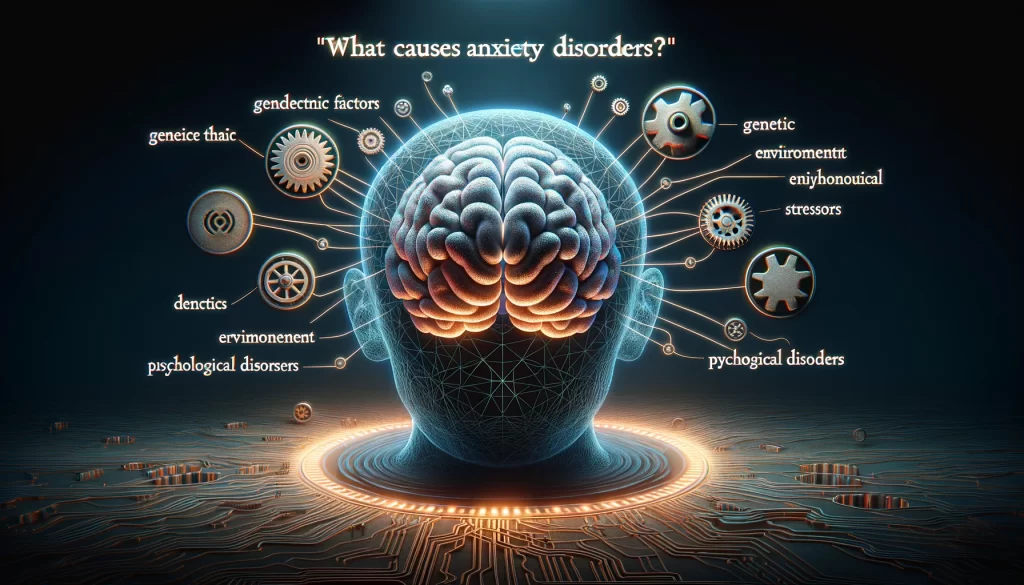Physical Address
304 North Cardinal St.
Dorchester Center, MA 02124

In today’s fast-paced world, the term “anxiety” often gets tossed around, yet its true nature remains veiled in misconceptions and half-truths. With “anxiety” and “anxiety disorder” being pivotal points of discussion, it’s crucial to peel back the layers and understand what lies beneath. This article endeavors to demystify anxiety, providing insights into its essence, impacts, and pathways towards management and healing.

Anxiety transcends mere worry or stress; it embodies a complex mix of emotions and physical signals that arise in response to perceived threats or challenges. This mechanism serves as an essential alert system in the human brain, designed to signal potential dangers and prepare the body for a fight-or-flight response. When activated appropriately, anxiety helps us respond swiftly and effectively to real threats, providing a vital survival function.
However, when anxiety persists beyond immediate threats or becomes easily triggered by everyday stresses, it can morph into a chronic condition, impeding normal life. This shift from a temporary state of alertness to a constant, overwhelming sense of fear is what distinguishes normal bouts of anxiety from anxiety disorders. Unlike the fleeting nervousness before a significant event, an anxiety disorder involves enduring, uncontrollable worry, affecting one’s ability to function in various aspects of life, including work, school, and personal relationships.

Anxiety disorders stand apart from the garden-variety anxiety that everyone experiences occasionally. They are not just an amplified version of the everyday stressors or worries but are characterized by their persistence, irrationality, and the significant distress they cause. These disorders form a category of mental health diagnoses that lead to excessive fear or worry, even in situations that are objectively non-threatening. The intensity and duration of these feelings are what differentiate anxiety disorders from the normal, adaptive anxiety everyone feels in response to stressors.
This classification includes various disorders such as generalized anxiety disorder (GAD), panic disorder, social anxiety disorder, and specific phobias, each with its own specific symptoms but all sharing the common thread of disproportionate and debilitating anxiety. Unlike normal anxiety, which is a fleeting response to a perceived threat, anxiety disorders persist for months, if not longer, significantly interfering with daily activities and the ability to lead a normal life. The transition from normal anxiety to an anxiety disorder marks a crucial threshold where professional intervention is often necessary to manage the symptoms and improve quality of life.

Symptoms of anxiety disorders can manifest in both physical and emotional dimensions, often intertwining to significantly disrupt daily life. Physically, individuals might experience symptoms such as an accelerated heartbeat, sweating, tremors, or fatigue. These physical manifestations are the body’s response to perceived threats, preparing for a fight-or-flight scenario even when no real danger exists. Additionally, headaches and muscle tension are common, as the body remains in a prolonged state of stress.
Emotionally, the impact of anxiety disorders extends to persistent worry, racing thoughts, and difficulty concentrating. Individuals may find themselves preoccupied with concerns about the future, leading to irritability and restlessness. This constant state of worry can make it challenging to focus on tasks, affecting productivity and personal relationships.
Moreover, anxiety disorders often disrupt sleep patterns, leading to insomnia or restless sleep. This lack of quality sleep can exacerbate other symptoms, creating a vicious cycle of anxiety. The persistence and severity of these symptoms are key in differentiating anxiety disorders from normal, everyday anxiety, marking a significant impact on an individual’s overall well-being and ability to function.

The origins of anxiety disorders are multifaceted, rooted in a combination of genetic, environmental, and psychological factors. Genetically, individuals may inherit a predisposition to anxiety, making them more susceptible to developing anxiety disorders when faced with certain life stressors. This genetic vulnerability interacts with environmental factors, such as traumatic experiences or prolonged exposure to stress, potentially triggering the onset of an anxiety disorder.
Psychological factors also play a critical role in the development of anxiety disorders. Patterns of thinking, learned behaviors from childhood, and coping mechanisms can influence how an individual responds to stress. For some, a tendency to perceive situations as more threatening than they are, or an inability to manage stress effectively, can lead to the development of anxiety symptoms.
Additionally, underlying medical conditions and the use of certain substances can precipitate or exacerbate anxiety disorders. Conditions such as heart disease, diabetes, or hormonal imbalances, along with substance abuse or withdrawal, can all contribute to anxiety symptoms. Understanding these causes is crucial for effective treatment and management of anxiety disorders, emphasizing the importance of a comprehensive approach that addresses both the physical and psychological aspects of anxiety.

Treatment for anxiety disorders often involves a multifaceted approach tailored to the individual’s specific needs. Psychotherapy, particularly Cognitive Behavioral Therapy (CBT), plays a central role in treatment. CBT helps individuals identify and challenge the negative thought patterns and behaviors contributing to their anxiety, teaching them coping strategies to manage symptoms more effectively. This type of therapy provides tools for dealing with anxiety in a healthy way, aiming to reduce its impact on daily life.
Medication can also be an essential component of treatment for some individuals with anxiety disorders. Antidepressants, anti-anxiety medications, and, in some cases, beta-blockers are used to manage symptoms, allowing individuals to participate more fully in psychotherapy and daily activities. Medication can offer significant relief from symptoms for many people, but it’s typically most effective when combined with psychotherapy.
Lifestyle changes and self-care practices contribute significantly to managing anxiety disorders. Regular physical activity, a balanced diet, sufficient sleep, and mindfulness practices like meditation can help reduce the overall level of stress and anxiety. Additionally, avoiding caffeine, alcohol, and nicotine, which can exacerbate anxiety symptoms, is recommended. These lifestyle adjustments, combined with professional treatment, can offer a holistic approach to managing anxiety disorders, enhancing the individual’s quality of life and overall well-being.

Misconceptions about anxiety often stem from a lack of understanding and awareness. Anxiety disorders are sometimes mistakenly seen as a choice or a character flaw, rather than recognized as legitimate medical conditions. This misunderstanding can lead to stigma, preventing individuals from seeking the help they need. The portrayal of anxiety in media and popular culture often simplifies or misrepresents the complexity and severity of anxiety disorders, further entrenching stereotypes and misconceptions.
Another factor contributing to these misconceptions is the invisible nature of anxiety disorders. Unlike physical illnesses, the symptoms of anxiety are not always visible to the outside observer, making it harder for some to understand the real impact on an individual’s daily life. This invisibility can lead to misunderstandings, with others perceiving those with anxiety disorders as overreacting to normal stress or not trying hard enough to overcome their fears.
Efforts to educate the public about mental health have started to shift perceptions, but there is still a long way to go. Raising awareness about the realities of anxiety disorders, including their causes, symptoms, and treatments, is crucial. By demystifying anxiety, society can foster a more empathetic and supportive environment for those affected, encouraging individuals to seek treatment and support without fear of judgment.

Supporting someone with an anxiety disorder begins with offering empathy and understanding. It’s important to recognize that anxiety disorders are real and challenging conditions, not something that can be easily controlled or willed away. Listening attentively and acknowledging their feelings without judgment can make a significant difference. Encouraging them to seek professional help and offering to assist with finding resources or attending appointments can also be very supportive.
Educating oneself about anxiety disorders can provide valuable insights into what the affected individual is experiencing. This knowledge can foster patience and help in identifying ways to offer practical support, whether through daily routines or during more challenging periods. Avoiding dismissive comments and instead validating their experiences can promote a supportive environment.
Creating a low-stress environment and being mindful of potential triggers can further assist individuals with anxiety disorders. Engaging in activities together that promote relaxation and well-being, such as walking in nature or practicing mindfulness, can be beneficial. Being a steady presence in their life, offering encouragement and celebrating small achievements, reinforces the message that they are not alone in their journey towards managing their anxiety.

Changing the narrative around anxiety starts with promoting education and understanding. Society can benefit from increased awareness campaigns that accurately depict the realities of living with an anxiety disorder. These initiatives can help dismantle myths and educate the public on the seriousness of anxiety disorders, moving away from stigmatizing attitudes and towards a more empathetic perspective. Encouraging open discussions about mental health in schools, workplaces, and within families can normalize seeking help and sharing experiences.
Media representation plays a crucial role in shaping societal attitudes. By advocating for more accurate portrayals of anxiety disorders in movies, TV shows, and news media, we can challenge harmful stereotypes and offer a more nuanced understanding. Highlighting stories of recovery and the effective management of anxiety can inspire hope and provide role models for those struggling in silence.
Finally, policy changes and advocacy are essential for providing accessible mental health services and support. By lobbying for better mental health resources, insurance coverage, and workplace policies that support mental well-being, society can create a more inclusive environment. This structural support is crucial for individuals to seek and receive the help they need, changing the narrative around anxiety from one of isolation to one of community and care.

Understanding and addressing anxiety is not just about treating an individual; it’s about shifting societal perceptions and creating a supportive environment that acknowledges mental health as an essential aspect of overall well-being. Education plays a pivotal role in this transformation. By accessing comprehensive resources on anxiety disorders, society can move towards a future where stigma is replaced with support, and individuals feel empowered to seek help.
The importance of community cannot be overstated in the journey toward mental health awareness. Organizations worldwide offer resources, support groups, and information that can guide individuals and their loved ones towards understanding and managing anxiety disorders. For example, websites like the Anxiety and Depression Association of America (ADAA) provide a wealth of information, including articles, treatment options, and support network details.
By fostering an inclusive and informed society, we can collectively contribute to a world where every individual, regardless of their mental health challenges, feels valued and supported. It’s a collective journey towards empathy, understanding, and action that begins with each one of us taking the step to learn more and spread awareness.




